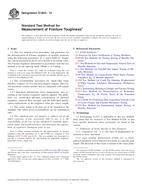Potrebujeme váš súhlas na využitie jednotlivých dát, aby sa vám okrem iného mohli ukazovať informácie týkajúce sa vašich záujmov. Súhlas udelíte kliknutím na tlačidlo „OK“.
ASTM E1820-13
Standard Test Method for Measurement of Fracture Toughness
Automaticky preložený názov:
Štandardná skúšobná metóda pre meranie lomovej húževnatosti
NORMA vydaná dňa 15.11.2013
Informácie o norme:
Označenie normy: ASTM E1820-13
Poznámka: NEPLATNÁ
Dátum vydania normy: 15.11.2013
Kód tovaru: NS-43176
Počet strán: 54
Približná hmotnosť: 162 g (0.36 libier)
Krajina: Americká technická norma
Kategória: Technické normy ASTM
Anotácia textu normy ASTM E1820-13 :
Keywords:
crack initiation, crack-tip opening displacement, CTOD, ductile fracture, elastic-plastic fracture toughness, fracture instability, J-integral, JIc, KJic, Jc, &delta,c, plane-strain fracture toughness, resistance curve, stable crack growth, ICS Number Code 77.040.10 (Mechanical testing of metals)
Doplňujúce informácie
| Significance and Use | ||||||||||||||||||||
|
5.1 Assuming the presence of a preexisting, sharp, fatigue crack, the material fracture toughness values identified by this test method characterize its resistance to: 5.1.1 These fracture toughness values may serve as a basis for material comparison, selection, and quality assurance. Fracture toughness can be used to rank materials within a similar yield strength range. 5.1.2 These fracture toughness values may serve as a basis for structural flaw tolerance assessment. Awareness of differences that may exist between laboratory test and field conditions is required to make proper flaw tolerance assessment. 5.2 The following cautionary statements are based on some observations. 5.2.1 Particular care must be exercised in applying to structural flaw tolerance assessment the fracture toughness value associated with fracture after some stable tearing has occurred. This response is characteristic of ferritic steel in the transition regime. This response is especially sensitive to material inhomogeneity and to constraint variations that may be induced by planar geometry, thickness differences, mode of loading, and structural details. 5.2.2 The J-R curve from bend-type specimens recommended by this test method (SE(B), C(T), and DC(T)) has been observed to be conservative with respect to results from tensile loading configurations. 5.2.3 The values of δ1.1 This test method covers procedures and guidelines for the determination of fracture toughness of metallic materials using the following parameters: 1.2 The recommended specimens are single-edge bend, [SE(B)], compact, [C(T)], and disk-shaped compact, [DC(T)]. All specimens contain notches that are sharpened with fatigue cracks. 1.2.1 Specimen dimensional (size) requirements vary according to the fracture toughness analysis applied. The guidelines are established through consideration of material toughness, material flow strength, and the individual qualification requirements of the toughness value per values sought. 1.3 The values stated in SI units are to be regarded as the standard. The values given in parentheses are for information only. 1.4 This standard does not purport to address all of the safety concerns, if any, associated with its use. It is the responsibility of the user of this standard to establish appropriate safety and health practices and determine the applicability of regulatory limitations prior to use.
|
|
Standard Test Methods for Tension Testing of Metallic Materials
|
|
Standard Test Method for Instrumented Impact Testing of Metallic Materials
|
|
Standard Guide for Evaluating Data Acquisition Systems Used in Cyclic Fatigue and Fracture Mechanics Testing (Includes all amendments and changes 8/14/2018).
|
|
Standard Test Method for Linear-Elastic Plane-Strain Fracture Toughness of Metallic Materials
|
|
Standard Test Methods for Notched Bar Impact Testing of Metallic Materials (Includes all amendments and changes 4/13/2023).
|
|
Standard Test Methods for Elevated Temperature Tension Tests of Metallic Materials
|
|
Standard Test Method for Determination of Reference Temperature, T0, for Ferritic Steels in the Transition Range (Includes all amendments and changes 3/6/2024).
|
|
Standard Practices for Force Calibration and Verification of Testing Machines
|
|
Standard Terminology Relating to Fatigue and Fracture Testing
|
|
Standard Test Method for Crack-Tip Opening Displacement (CTOD) Fracture Toughness Measurement |
Odporúčame:
Aktualizácia technických noriem
Chcete mať istotu, že používate len platné technické normy?
Ponúkame Vám riešenie, ktoré Vám zaistí mesačný prehľad o aktuálnosti noriem, ktoré používate.
Chcete vedieť viac informácií ? Pozrite sa na túto stránku.




 Cookies
Cookies
